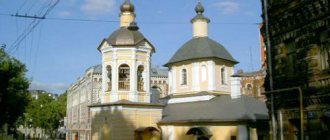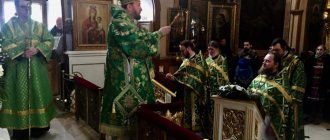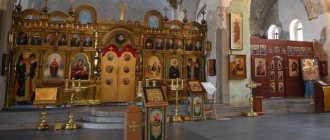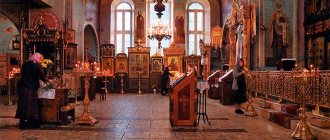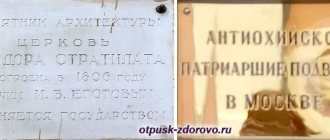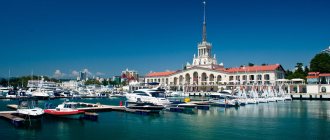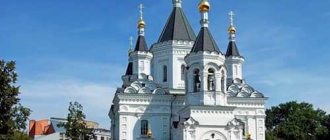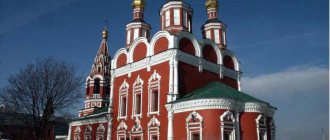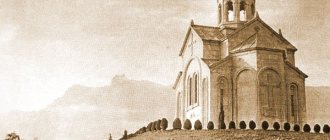Share
A long time ago, in the 15th – early 16th centuries, the Ivanovsky Monastery stood on the site between today’s Ordynka and Pyatnitskaya streets. And on its territory there is a wooden church of the Holy Prince Michael and Boyar Theodore, Chernigov Wonderworkers, known since 1625. It was also called the Mikhailo-Feodorovskaya or Chernigov Church. And they placed it exactly at the meeting place of the relics of Mikhail and Theodore of Chernigov, who died a terrible death in the Horde in 1246, brought to Moscow. In 1675, the dilapidated wooden temple was dismantled. And in its place, with the help of the Moscow merchant Juliana Ivanovna Malyutin, like a white swan, a snow-white stone beauty-church ascended. Oh, it’s a pity that we don’t know the name of the architect and the craftsmen who built this snow-white miracle! By God, if I knew, I would list everyone by name, and I would bow at the feet of their memory for the amazing beauty that they left us! Even before the revolution, academician, architectural historian, member of the commission for the preservation of ancient monuments Andrei Mikhailovich Pavlinov called the 17th century “the golden age of Russian architecture.” And looking at the Chernigov church, you understand: the academician was right, oh, so right! Rus' shook itself off from the Mongol yoke, breathed the air of freedom, blossomed... And, of course, the dawn was expressed primarily in Orthodox architecture. It was then that, along with the canonical, traditional temples, many others appeared to the world, among which fire temples especially stood out. About 300 of them were built in Moscow and the Moscow region alone. The Chernigov temple is one of the fiery ones. The tall quadrangle (tetrahedron) ends with two rows of pointed keel-shaped kokoshniks, similar to tongues of flame, and is crowned with five chapters - symbols of Christ and the four evangelists. A low refectory adjoins the temple, and the composition is completed by a tent-roofed bell tower. It should be noted that after Moscow, fire temples began to be widely built throughout Rus'. And they are rightfully considered bright symbols of Russian civilization. In Soviet times - in the 70-80s - the building of the Chernigov temple was carefully restored: the domes were restored and covered with emerald tiles, the top with kokoshniks was uncovered, and the walls were whitewashed. And in 1991 they returned it to the believers. And you and I are once again given the opportunity to admire the amazing beauty of the Chernigov church. Her current address, by the way, is Chernigovsky Lane, building 3.
About the place
The Chernigov Patriarchal Metochion in Moscow began its history back when the Tatar-Mongol yoke was being imposed on Russian soil. Here is a temple that was built in honor of the cutting off of the head of the Baptist John before Bor. These places are the oldest in the entire capital.
Previously, the street was called Lenivka, and Zamoskvorechye was known as Zarechye. Everything that is here now grew out of an unremarkable craftsmen's settlement that was on the outskirts of the city.
In those places where the Chernigov courtyard of Moscow appeared, there used to be a trade road, and around you could see a dense forest. That is why the church, ancient and picturesque, was described as the one located near Bor. The Chernigov courtyard in Moscow is colorfully described in a chronicle dated 1415. Then it was called the Ivanovo Monastery. This name was given in honor of John the Baptist. According to the scripture, it was to him that the father of Vasily the Dark II came when the future tsar was just being born, since childbirth was painful.
The Chernigov Patriarchal Metochion in Moscow changed its name back in 1564, when it was called the Church of Paraskeva Pyatnitsa. In general, this building is considered the first stone church in the entire Zarechye region. It replaced an aged and out-of-use wooden structure. Since 1578, Ivan the Terrible, with the support of the people, ordered the remains of Mikhail, the Grand Duke, as well as the boyar Fyodor, who died a martyr’s death at the hands of the Horde in 1245, to be transferred here from Chernigov.
Chernigov courtyard - the treasure of old Moscow
This year marks the 600th anniversary of the Chernigov courtyard on Pyatnitskaya Street. For its anniversary, the courtyard complex, which includes architectural monuments of the 14th–15th centuries, underwent another restoration.
Moscow during the Mongol-Tatar yoke
Temple of the Beheading of John the Baptist near Bor
Few people know that one of the oldest streets in Moscow, Pyatnitskaya, was originally called Lenivka. At that time, Zamoskvorechye - “Zarechye” - was a poor craft settlement on the outskirts of Moscow and was located on a trade road, surrounded by dense forests. Therefore, the wooden church that was located here in those days was called the “Church near Bor”. It was first mentioned in chronicles in 1415 as the Ivanovo (in honor of St. John the Baptist) monastery, to whose monk the “restless father” of Grand Duke Vasily II the Dark turned to during his painful birth. And the famous Church of Paraskeva Pyatnitsa, in whose honor Lenivka Street was renamed Pyatnitskaya, will appear only in 1564 - almost 150 years later!
It was the Church of the Beheading of John the Baptist, erected on the site of a dilapidated wooden monastery church in 1514, that became the first stone church in Zarechye. Here, near the walls of the renovated church, in 1578, the people led by Tsar Ivan the Terrible solemnly met the relics of Prince Mikhail and his faithful boyar Fedor, who died as martyrs in the Horde in 1245, transferred from Chernigov.
Refectory
The place where the relics met was not chosen by chance. Ordynka Street, located next to Pyatnitskaya, got its name because the road to the Golden Horde ran along it. Tatar merchants arrived in Moscow from this direction, and Russian-Tatar interpreters (translators) also lived here - hence the names of the nearest Tolmachevsky lanes. It was along Ordynka that the relics of the saints arrived in Moscow after the fall of the Tatar yoke. In memory of this meeting, next to the Church of John the Baptist, another wooden temple was built in the name of the Chernigov miracle workers.
In 2011, when archaeologists were restoring the foundations of this ancient church, a burial and a 17th-century tombstone were discovered under the floor. An inscription in Old Slavic has been preserved on the stone, indicating that the famous merchant of the cloth hundred, the ancestor of the Malyutin family, who participated in the adoption of the first Moscow Trade Charter, rests here. It is believed that it was he who bequeathed to his wife to build a stone church of Saints Michael and Fyodor in place of a wooden one - at that time this was considered a very generous gesture.
The lane formed between the two churches was called Chernigovsky. It has an amazing shape - with a total length of only 200 meters, it has two turns at right angles.
The temple complex was finally formed only in 1781 and, together with Russia, survived all historical events: the Yoke, the Time of Troubles, Peter's reforms and all wars.
Chernigov courtyard today
In 1917, the churches of Chernigovsky Lane were closed. In the 1930s, the bells were thrown off and the premises were used as warehouses. According to eyewitnesses, the courtyard was so desecrated that toilets were installed in the altars. Only in 1977, on the eve of the Moscow Olympics, both churches with a bell tower were partially restored, and domes and crosses appeared on them again. In 1991, the Church of the Chernigov Martyrs was returned to the Church. Since 2009, restoration work has been carried out in the Church of the Beheading of John the Baptist, which was completed by November 1 of this year.
“From the old building, white stone fragments have been preserved in the foundations and basement, and in the interiors we found paintings from the 17th and 19th centuries,” restorer Alexander Chorba tells TD. “It was very important for us to preserve what little remained of the original materials, so we conserved them for future generations. The surviving fragments are not visible from the outside - we “hid” them under several layers of plaster, on top of which we made new paintings. Our descendants will be able to carefully remove layer by layer so as not to damage them and see them in the most preserved form.
Alexander reminds that conservation and restoration are not the same thing: conservation is aimed at preserving ruins, and restoration is aimed at restoring authentic ancient parts.
“We had to completely re-paint the Church of the Beheading of John the Baptist,” says icon painter Mikhail. - We have a large staff of artists, many of them are foreigners. To ensure that the work is coordinated and the painting uniform, before starting work, a project is drawn up, in which the style and primary colors are determined. Next, we choose our fragments and paint them separately.
A modern icon painter does not have to fast and pray before starting work, as was customary in Rus' in ancient times, says Mikhail. And wall paintings are now very rarely done using wet plaster, affresco: this is too long and complicated a process. Paints use silicate and acrylic paints. Natural - only partially.
“All this is explained by economic and time resources,” explains Alexander Chorba. “It took us about a year to paint this temple alone; more than thirty icon painters worked on it. But this does not mean that the approach of modern masters is superficial: yes, they are canonically not required to fast and pray before starting work, but they are all believers and churchgoers, many take a blessing from their confessor before starting painting.
Chernigovsky Lane is interesting not only for its ancient churches - it also has preserved houses built several centuries ago. Some of them house a higher educational institution of the Russian Orthodox Church - the All-Church Postgraduate and Doctoral Studies named after Saints Cyril and Methodius. And, for example, house No. 19/13, where the Foundation of Slavic Literature and Culture is now located, is a former estate of the 17th-19th centuries, the chambers of which were erected back in the 17th century. It seems that everything in this alley conveys the atmosphere of old Moscow.
Photo by the author
Dining room
It was in the refectory that the relics were met. And there is a reasonable explanation for this. The fact is that the street called Ordynka, which is near Pyatnitskaya, is called that way because through it it was possible to contact representatives of the Golden Horde. The Chernigov courtyard in Moscow was a link between the capital and the Tatar merchants who came here. In addition, interpreters (that is, translators) lived here. The Tolmachevsky lanes, which are located nearby, are named in honor of this.
Along Ordynka, the same holy remains arrived in the Chernigov courtyard in Moscow when the Tatar yoke fell. To perpetuate this memorable event, another building was created near the temple, dedicated to the miracle workers.
First restoration
When the city was preparing to host the 1980 Olympics and welcome foreigners, many architectural monuments began to be restored. These two churches were also lucky, where today the Chernigov courtyard is located. Restoration work began in Moscow, which, in addition to the main buildings, affected the bell tower and the refectory, located here. They worked conscientiously. They restored the dome and crosses, covered the domes with tiles, whitewashed and plastered the walls, installed a lattice and fence. The restoration continued after the Olympic Games were completed, until 1984. It is interesting that during this period the buildings did not belong to the Orthodox Church, but to the Ministry of Construction Materials. There was even an exhibition hall called “Art Glass”.
Restoration work
The year 2011 is notable for the fact that then archaeologists restored the foundation of this old church. During this process, under the thickness of the floor, remains and a tombstone were suddenly found, which was dated to the 17th century. The inscriptions are written in Old Slavonic. They contained information that the founder of the Malyutin family, who was a participant in the Trade Charter, the first in Moscow, rests here.
Before his death, this man bequeathed to his wife that she build a temple of stone, instead of the one that stood here of wood. At that time it was not a cheap operation and you had to pay a lot for it. The span located between the two churches is called Chernigovsky. It has a great shape. The total length is 200 m, there are two turns, between which there is a right angle. The final formation of the complex ended in 1781. Together with the state, this place had to go through the sharpest turns: the yoke, the difficult Time of Troubles, Peter's steep reforms and military actions.
Nowadays
In 1917, the local churches were closed. In the 1930s, the bells were removed from the roofs and the premises were converted into storage areas. Eyewitnesses said that shrines were desecrated and toilets were installed on the altars. For a long time this place was empty, until in 1977 two churches were restored as part of the preparation program for the Olympics, which took place in Moscow. The crosses and beautiful domes were returned. The year 1991 is characterized by the fact that the Church of the Martyrs became part of this complex. Since 2009, restoration has also been carried out here, which was completed only recently.
Activities of the parish[edit]
- The compound accepts deaf-blind and disabled orphans from the Sergiev Posad orphanage for recreation and family-type rehabilitation.
By the decision of His Holiness Patriarch Kirill of Moscow and All Rus' in 2013, at the Metochion of the Holy Trinity Sergius Lavra in Gelendzhik, recreation was approved for free for disabled orphans from the Sergiev Posad orphanage for the deaf-blind. Initially, this task was set for the metochion by Archbishop Feognost of Sergiev Posad. Children at the Compound go to church, sing the Divine Liturgy on their own and deliver sermons. Thanks to the opportunity to stay at the STSL Compound in Gelendzhik, disabled orphans not only have a rest, but also undergo family-type rehabilitation: they cook their own food, clean the premises, relax at the sea, and communicate with parishioners.
Legacy for posterity
The old building is reminiscent of the remaining white stone fragments, as well as the foundations and basement. The interiors have paintings dating back to the 17th-19th centuries. Those people who carried out the restoration tried to do everything possible to preserve the original materials that were preserved so that future generations could see them.
When viewed from the outside, some parts may go unnoticed. There is a thick layer of plaster on top, and under it you can see the updated paintings. Everything is done in such a way that in the future the layers can be removed and the relics of antiquity can be discovered without harming them. They must be preserved with the utmost care. Come and see for yourself what a wonderful place the Chernigov Compound is in Moscow. Address: Pyatnitskaya st., 4/2, building 5.
